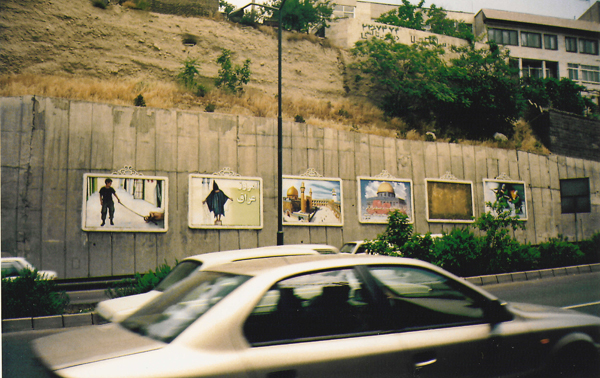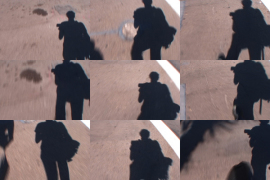
Negar Mottahedeh: Image as Event

I would like to begin my presentation this week where Melani McAlister left off: on the spectacle of Abu Ghraib. Here, with a series of images that I captured with my camera as we were driving along the Sadr freeway in Tehran two summers ago. The following is an excerpt from a piece I wrote on the presence and role of the photographs from Abu Ghraib in Tehran : -------------
Air-conditioned transportation in Tehran is notoriously difficult to find. For pampered visitors such as the cultural anthropologists and documentary filmmakers from New York and Los Angeles who seem to converge on the Iranian capital every summer, a cool taxi ride to the northern parts of town recalls something of the charmed life they left behind in the United States, a life some refer to offhandedly as "the grid."
Being on the grid, it seems, is something akin to having a non-Iranian passport or a green card, multiple credit cards loaded with debt, a laptop with a 24-hour DSL connection, satellite television in an air-filtered apartment, impeccably pedicured feet in open-toe sandals, a single Gauloise cigarette ashing in a saucer next to that daily injection of coffee and money earned from a steady job. This is not to say that some of these components of the grid are not available in Tehran. They are. Apartment complexes in the northern parts of town, like Shahrak-e Qarb, also provide residents with hilly, green outdoor spaces where a woman can walk her dog without the government-prescribed full body covering and headscarf. Such private complexes come with in-house supermarkets, boxed meals delivered to your door and a doorman who will call a taxi and announce visitors just as he might at a one-bedroom pad in New York. In Tehran, all this comes to about $500 a month.
In our time of total war, however, Tehran visitors' moniker for the good life also evokes the frightening world of intelligence gathering networks and terrorists recently fictionalized in the TNT miniseries THE GRID. In this terrifying world, some of those visitors, wittingly or no, have acted to embed the particulars of Iranian cultural and social life -- particularly those related to Iranian women -- into visions for Iran's future that are generated in a grid entirely different from their matrix of material comforts. It cannot be coincidental that the memoirs by Iranian female authors now living in the West, such as those of Firoozeh Dumas, Marjaneh Satrapi and Azar Nafisi, have found such phenomenal commercial success at a time when Washington hawks would like these authors' country of birth to be the next battleground in the total war of the twenty-first century.
.....(I'll say more on this in subsequent postings).....
Driving north on the Sadr freeway in Tehran in the summer of 2004, I came across a series of images covering the soundproofed walls of the opposite lane. The first panel from the left was a painted reproduction of the infamous photograph of the uniformed Pfc. Lynndie England holding a leash tied to the neck of an Iraqi prisoner who curls naked in a fetal position on the Abu Ghraib prison floor. This image sent shock waves around the world, as did the one reproduced in the second panel, a hooded Iraqi prisoner balancing on a platform with electrical wires attached to his limbs and genitals.
Such haunting images of humiliating torture reinforced for many the admonitions of Col. Mathieu in THE BATTLE OF ALGIERS, the famous film on guerrilla warfare now reportedly in vogue at the Pentagon. The colonel's words impressed on the audiences of the early 1960s, as they do to the global multitude today, that the continued presence of an imperial military where it is not wanted requires it to identify sources of populist agitation by any means necessary. An ordinary citizen's support of the occupation, whether in the name of liberation or in the name of progress, implies his or her tacit acceptance of all the repercussions of military force, including torture.
Passing these reproductions of domination on the freeway, I was struck by the imprints of the hand that had transformed their texture from photographs into painted images. I was also struck by the words that were written in Farsi to one side of the second panel: "Emrooz Iraq." "Today Iraq." It is an auspicious caption that almost reads like an alert on a mobile phone: "This is Iraq today." The third and fourth panels in the series represented the site of pilgrimage in Mecca and the shrine of Imam Ali, the son-in-law of the Prophet Muhammad. A quotation attributed to Imam Ali appeared across the fourth image. It calls upon the believer to be the enemy of tyranny and a supporter of the victim of injustice. Following a gap on the wall, a final panel captured three soldiers on bended knee surrounded by smoke and fire in combat.
The last heavy combat Iranian soldiers saw was the vicious eight-year war between Iran and Iraq, for which Iran sacrificed the majority of its male labor force, men who would now be in their thirties, forties or early fifties. Seen from the perspective of that war, the messages communicated in the fusion of these five panels seemed ambiguous at best. The images arrived as both the bearers of the latest news -- "Today Iraq" -- and a prescription for pious living. "Be a force against evil and a defender of the good." They carried both a reminder of a crucial duty for the devout and a powerful picture of military retaliation. They were a broken phrase, an unfinished visual exhortation to an end open to question.
....
After my return from Tehran in the summer, I received a photograph of the panels I had seen on the Sadr freeway. The fifth of the six panels had gone up to fill the gap on the wall. There are two men in it. One is laying face down on a red carpet, and the other, sitting next to him, looks out of the frame toward the sixth panel depicting the three men engaged in military combat. The caption on the left side of the fifth panel reads: "Dirooz Filistin." Yesterday Palestine.
While the messages and meanings of the images of torture in US jails in Iraq are being muted in the global media with visual rhetoric that justifies the occupation, and does so by promoting images of women's bodies that have been liberated in hair salons [in Afghanistan for example], the Iranian government is promoting images of prison tortures toward different ends. These images of humiliating violence in US-occupied Iraq are hung in close proximity to images that remind the viewer of the inequities of Israeli occupation in Palestine. Close to images that remind the viewer of what has long kept the region so distraught, and that has contributed to a colre du lait (milk anger) that, like milk, boils into sudden rage when heated. In Tehran too, the question is the question of occupation.
> Negar Mottahedeh

